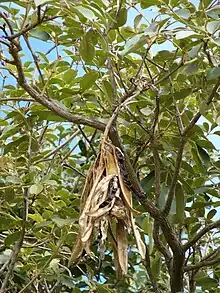| Handroanthus serratifolius | |
|---|---|
 | |
| Scientific classification | |
| Kingdom: | Plantae |
| Clade: | Tracheophytes |
| Clade: | Angiosperms |
| Clade: | Eudicots |
| Clade: | Asterids |
| Order: | Lamiales |
| Family: | Bignoniaceae |
| Genus: | Handroanthus |
| Species: | H. serratifolius |
| Binomial name | |
| Handroanthus serratifolius (Vahl) S.O. Grose | |
| Synonyms | |
|
Bignonia serratifolia Vahl | |


Handroanthus serratifolius is a species of tree, commonly known as yellow lapacho, pau d'arco, yellow poui, yellow ipe, pau d'arco amarelo, or ipê-amarelo.[1][2]
Description
It is a tree native to forests throughout Central and South America. This plant grows in the cerrado vegetation of Brazil, reaching up to French Guiana, Bolivia, Paraguay and Northern Argentina.
It is one of the largest and strongest of tropical forest trees, growing up to 150 feet (46 m) tall while the base can be 4–7 feet (1.2–2.1 m) in diameter.
Uses
It is a commercially farmed hardwood notable for its extreme hardness and resistance to fire and pests. It is sometimes traded as an "ironwood", or just as "ipê" (the entire genus Tabebuia), or as lapacho (properly Handroanthus serratifolius)
Chemistry
The bark of Handroanthus serratifolius contains chemical compounds including lapachol, quercetin, and other flavonoids.
National Flower of Brazil
The national flower of Brazil is the ipe-amarelo. The ipe-amarelo is actually a flowering tree that blooms in bright yellow flowers during the months of September and October. Blooms only last about a week.[3]
References
- ↑ "Handroanthus serratifolius". Integrated Taxonomic Information System.
- ↑ "Handroanthus serratifolius". The Plant List. Retrieved 15 September 2017.
- ↑ "National Flower of Brazil - Handroanthus serratifolius". 9 March 2022.